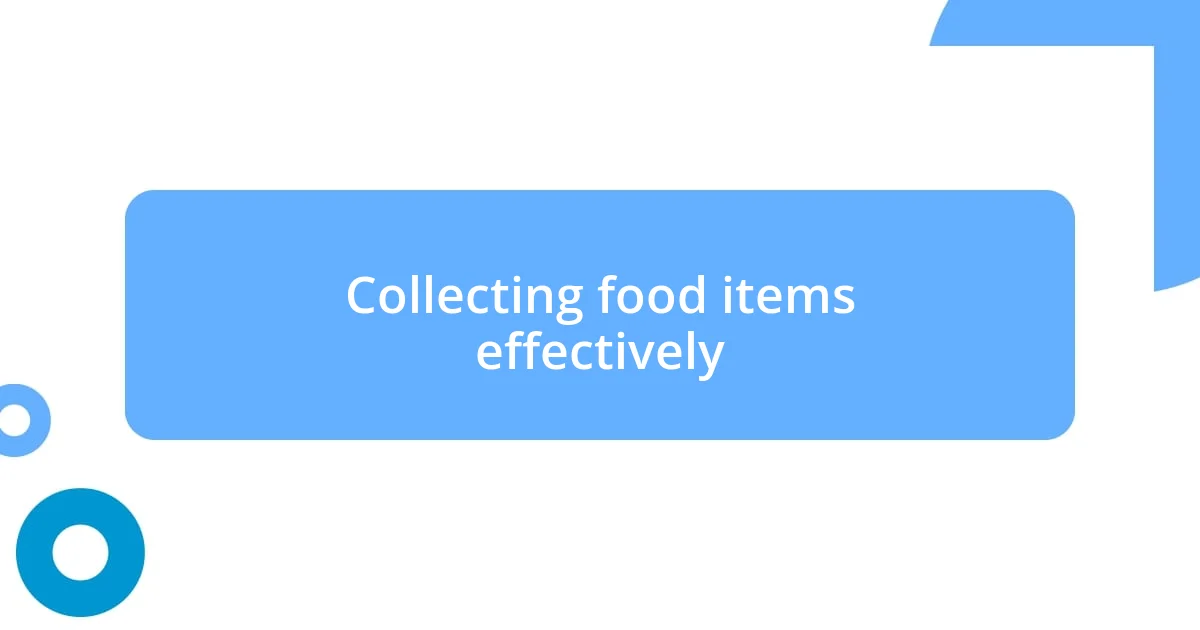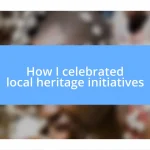Key takeaways:
- Food drives strengthen community bonds by bringing people together for a common purpose, fostering support and friendship.
- Effective planning, including understanding local needs and engaging community members, is crucial for successful food drive organization and participation.
- Reflecting on the impact of food drives highlights the importance of awareness around food insecurity and the connections formed among volunteers and recipients.

Understanding food drives benefits
One major benefit of food drives is their ability to strengthen community ties. I remember volunteering at a local food drive last year, where families came together to donate and pack food items. It was heartwarming to see neighbors collaborating, forming bonds over a shared purpose – helping those in need. Isn’t it amazing how a simple act of giving can create a network of support and friendship?
Additionally, food drives can significantly raise awareness about food insecurity in our communities. When I organized a food drive at my workplace, many people were surprised to learn how many families in our area struggled with hunger daily. This sparked conversations about food access and encouraged colleagues to become more involved in local initiatives. It made me realize that by participating in a food drive, we not only provide direct assistance but also educate ourselves and others on critical social issues we might not have been aware of before.
Moreover, the impact of contributing to food drives extends beyond immediate donations. Recently, I participated in a drive that focused on providing nutritious foods, which made me reflect on the importance of food quality. It’s not just about filling pantries; it’s about making sure those in need receive healthy options. Have you ever considered how the foods we choose to donate can affect the wellbeing of others? This understanding deepens our connection with the community and inspires more thoughtful contributions in the future.

Planning my food drive participation
Before diving into participating in a food drive, I found that planning was essential. I realized I needed to identify the cause that resonated with me most. For instance, after reflecting on my own experiences with hunger during college, I was motivated to focus on supporting local food banks. This personal connection drove me to research organizations in my area and determine what specific items were most needed.
Here’s a quick overview of my planning process:
- Research local food banks to understand their specific needs.
- Connect with community members to gather insights about common donation practices.
- Set a timeline for when donations will be collected and delivered.
- Create promotional materials to engage more people in the drive, such as flyers and social media posts.
Creating this roadmap not only made the food drive more organized, but also allowed me to channel my passion and empathy into meaningful action. I felt a sense of ownership over the process, which made the actual participation even more rewarding. It was a chance for me to give back in a way that felt personal and impactful.

Collecting food items effectively
Collecting food items effectively requires a blend of strategy and community involvement. When I started coordinating a food drive in my neighborhood, I found that organizing collection points at easily accessible locations made a huge difference. For instance, partnering with local businesses and schools significantly increased the volume of donations. People were more likely to contribute if they didn’t have to go out of their way. It’s fascinating how a little thought about logistics can amplify the impact of a collection effort!
Another strategy I employed was using visual cues to attract attention and encourage donations. I remember creating bright signs and setting up food display bins that showcased the items we needed most. By displaying examples of high-demand items, like canned vegetables and pasta, I noticed a marked improvement in what people donated. It sparked curiosity and made it easier for others to understand what to contribute. Have you ever thought about how visuals can guide and encourage action? In my experience, simple displays make a big impact!
To enhance our collection efforts, I focused on creating a sense of urgency and excitement. I organized a themed collection day that invited families to donate while enjoying activities like a potluck dinner. Connecting food donations with community fun not only engaged more people but cultivated a festive atmosphere. I truly believed I was nurturing a spirit of collaboration, where donating was not just a chore but a celebration of generosity.
| Collection Method | Description |
|---|---|
| Partnering with Local Businesses | Setting up food drives in easily accessible locations encourages spontaneity in giving. |
| Using Visual Cues | Display bins and clear examples of needed items motivate contributions and clear understanding. |
| Hosting Themed Events | A festive atmosphere promotes community involvement and transforms donating into a fun activity. |

Engaging community volunteers
Engaging community volunteers was a pivotal part of my food drive experience. One of the most rewarding moments came when I hosted an informational session to gather interested volunteers. I vividly remember the excitement in the room as we shared stories and ideas. It felt like we were building a small family united by a common goal. Have you ever felt that electric buzz of purpose when surrounded by like-minded people? It’s a feeling that drives us to act.
I also found that keeping volunteers motivated was crucial for a successful food drive. After our initial meeting, I established a group chat to share progress updates and success stories. I made it a point to celebrate every small win, whether it was hitting our first donation milestone or a heartwarming photo of a volunteer with a donation bag. Through this, I created a culture of appreciation and positivity. It’s incredible how a little acknowledgment goes a long way in sustaining enthusiasm, don’t you think?
Finally, I learned the importance of aligning tasks with volunteers’ strengths and interests. I once had a volunteer who was an amazing graphic designer, and she took charge of creating eye-catching promotional materials. Meanwhile, others with a passion for community engagement led efforts to reach out to local media. By highlighting individual talents, I noticed that everyone felt valued and more committed. Have you realized how aligning passion with purpose can elevate collective efforts? In my experience, it’s the secret ingredient to a successful food drive.

Promoting the food drive
Promoting the food drive involved tapping into the local community’s spirit. I remember standing outside a popular grocery store one Saturday, chatting with shoppers about our mission. The expressions I saw—curiosity, concern, and engagement—encouraged many to not just listen, but actually consider how they could help. It was powerful to witness, transforming a simple conversation into a call for action. Have you ever felt the energy shift in a room or space when people connect over a shared goal?
Social media also played a crucial role in our promotion efforts. I crafted eye-catching posts highlighting our progress and the impact of every donation we received. Each time I shared a photo of filled collection bins, I felt a wave of excitement wash over me as friends and followers would comment, share, and encourage others to pitch in. It’s remarkable how a vibrant online presence can amplify a grassroots effort. Have you experienced how digital communities can unite people over a cause? In my case, it served as a catalyst for sparking interest and commitment.
Additionally, collaborating with local influencers turned out to be a game changer. When I connected with a local chef known for her community initiatives, she graciously agreed to promote our food drive through her channels. Her endorsement brought a fresh wave of interest, leading to a significant uptick in donations. I vividly recall the day she shared a video encouraging her followers to participate—it felt like the exciting aftershock of a team victory! It’s funny how a small collaboration can open doors to new opportunities, right? For me, realizing the power of community connections solidified the food drive’s grassroots success.

Organizing the food distribution
Once the donations started rolling in, organizing the food distribution became a thrilling yet challenging task. I recall the day we gathered at the community center, boxes piled high with food donations. It was both chaotic and exhilarating, and everyone jumped in to help sort items. Some shuffled through canned goods while others organized fresh produce. Watching people come together like this reminded me of a puzzle, where every piece fits perfectly. Have you ever experienced that rush of teamwork, where efforts seamlessly align toward a common purpose?
To ensure efficiency, I created a simple system for categorizing food items. I remember when we devised bright color-coded labels: green for vegetables, red for canned goods, and yellow for grains. This small touch made a noticeable difference—I was pleasantly surprised by how quickly we transformed the jumble into a well-organized setup. It made me think about how even the slightest planning can bring order to chaos. Isn’t it fascinating how thoughtful organization can enhance productivity?
On the day of distribution, I felt a wave of emotions as families began to arrive. As we handed out food boxes, I noticed the gratitude in their eyes—it was a rewarding realization that our efforts truly mattered. I shared laughs and stories with some of the recipients. It felt like the food was just an excuse to foster connections and create a sense of community. Ever felt that warm glow when you know you’ve made a difference? Those moments reaffirmed my belief in the power of kindness and community spirit.

Reflecting on my impact
Reflecting on the impact of my involvement in the food drives often brings a smile to my face. Each interaction with community members reinforced the idea that even small contributions can create ripples of change. I vividly remember watching a young mother’s face light up when we handed her a bag of groceries; the sheer relief and gratitude radiating from her was a powerful testament to why we do this. Have you ever felt that rush of purpose flood over you when you realize your efforts have touched someone’s life?
As I look back, I find myself pondering the connections formed along the way. The volunteers and I shared a bond that evolved beyond just sorting cans and packing boxes. Those spontaneous moments—laughing over a misplaced food item or sharing a heartfelt story—transformed us into a community. I often think about how these interactions not only filled empty stomachs but also nourished our spirits. Isn’t it fascinating how collective action creates lasting relationships?
Another aspect that strikes me is the awareness we raised about food insecurity. While I initially focused on logistics, I began to realize how crucial it was to inform others about the ongoing struggles faced by many in our community. I remember a heated discussion during one of our meetings where we brainstormed ways to address misconceptions about hunger. It felt invigorating to know our efforts extended beyond distribution; we were creating a narrative that could inspire others to get involved. Has your experience ever shown you that understanding drives compassion? That realization continues to motivate me even today.














